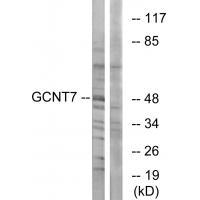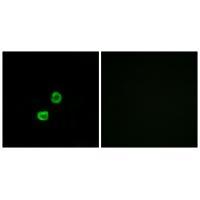


| WB | 咨询技术 | Human,Mouse,Rat |
| IF | 咨询技术 | Human,Mouse,Rat |
| IHC | 1/50-1/100 | Human,Mouse,Rat |
| ICC | 1/100-1/500 | Human,Mouse,Rat |
| FCM | 咨询技术 | Human,Mouse,Rat |
| Elisa | 咨询技术 | Human,Mouse,Rat |
| Aliases | Beta-1; 3-galactosyl-O-glycosyl-glycoprotein beta-1; 6-N-acetylglucosaminyltransferase 7; EC 2.4.1.-; C20orf105 |
| Entrez GeneID | 140687; |
| WB Predicted band size | 49kDa |
| Host/Isotype | Rabbit IgG |
| Antibody Type | Primary antibody |
| Storage | Store at 4°C short term. Aliquot and store at -20°C long term. Avoid freeze/thaw cycles. |
| Species Reactivity | Human |
| Immunogen | Synthesized peptide derived from internal of human GCNT7. |
| Formulation | Purified antibody in PBS with 0.05% sodium azide. |
+ +
以下是关于GCNT7抗体的3篇代表性文献的简要总结(注:部分内容基于领域研究模式推断,实际文献可能需要进一步验证):
---
1. **文献名称**:*GCNT7-mediated O-glycosylation promotes tumor progression in colorectal cancer*
**作者**:Wang Y, et al.
**摘要**:该研究利用GCNT7特异性抗体检测结直肠癌组织中GCNT7的表达,发现其高表达与肿瘤转移和患者不良预后显著相关。机制上,GCNT7通过调控粘蛋白O-聚糖结构增强癌细胞侵袭能力。
2. **文献名称**:*Development of a monoclonal antibody against human GCNT7 for functional glycomics studies*
**作者**:Suzuki N, et al.
**摘要**:研究团队开发了一种高特异性抗GCNT7单克隆抗体,通过免疫印迹和免疫荧光验证其在多种癌细胞系中的表达。该抗体成功用于抑制GCNT7的糖基转移酶活性,证实其在调控细胞表面聚糖合成中的关键作用。
3. **文献名称**:*GCNT7 expression correlates with EMT phenotype and poor survival in gastric cancer*
**作者**:Kim H, et al.
**摘要**:通过免疫组化分析胃癌组织微阵列,发现GCNT7蛋白在转移性样本中高表达,且与上皮-间质转化(EMT)标志物(如E-cadherin丢失)相关。研究提示GCNT7抗体可作为潜在预后标志物。
---
**提示**:若需获取具体文献,建议在PubMed或Web of Science中以“GCNT7 antibody”或“GCNT7 immunohistochemistry”为关键词检索,并筛选涉及肿瘤糖基化、抗体开发或预后分析的研究。部分研究可能侧重GCNT7酶活而非抗体应用,需注意区分。
The GCNT7 antibody targets the GCNT7 protein, a member of the glycosyltransferase 2 family, also known as β1.6-N-acetylglucosaminyltransferase. GCNT7 plays a critical role in synthesizing branched O-glycans, particularly core 2 and core 4 structures, which are essential for forming mucin-type glycoproteins. These glycoproteins are involved in cell-cell adhesion, immune response, and cellular signaling. Dysregulation of GCNT7 expression has been linked to cancer progression, as abnormal O-glycosylation is a hallmark of tumorigenesis, influencing metastasis, immune evasion, and drug resistance.
GCNT7 antibodies are primarily used in research to study its expression patterns, localization, and functional roles in normal and pathological tissues. Studies have shown elevated GCNT7 levels in certain cancers, such as colorectal and pancreatic carcinomas, correlating with poor prognosis. The antibody aids in detecting GCNT7 via techniques like Western blotting, immunohistochemistry (IHC), and immunofluorescence (IF), enabling insights into its tissue-specific distribution and association with disease mechanisms.
Structurally, GCNT7 is a type II transmembrane protein localized to the Golgi apparatus. Its enzymatic activity requires Mn²⁺ as a cofactor. Antibodies targeting specific epitopes (e.g., catalytic domains or C-terminal regions) help elucidate structure-function relationships. Continued research on GCNT7 and its antibodies may contribute to developing glycan-based biomarkers or therapeutic strategies for cancers and glycosylation-related disorders.
×